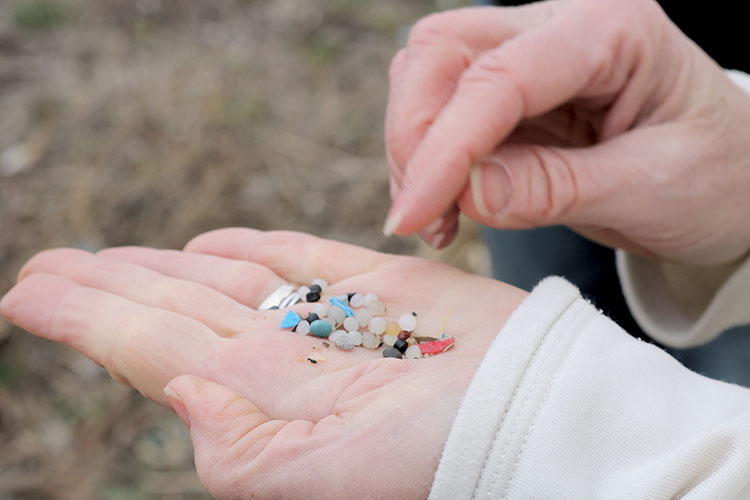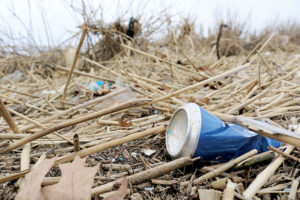By Jay Cook |
SANDY HOOK – Although they’re technically not in the waste management business, Clean Ocean Action has been plenty busy cleaning beaches over the last three decades.
But pleas to eliminate trash, litter and debris on New Jersey’s Atlantic Coast beaches and waterways are seemingly falling on deaf ears, as the environmental group’s latest report notes that volunteers in 2017 collected a record-setting number of plastic products and other trash harmful to marine environments.

“This is a trend we are seeing,” Cindy Zipf, Clean Ocean Action’s executive director, said at a press conference last week. “Plastic is going up, up, up because of our wasteful and disposable society. That has permanent and long-term consequences to the marine life that lives out there.”
Last year, 7,416 volunteers organized by Clean Ocean Action picked up 373,686 pieces of debris from over 60 sites in 53 towns and parks along the Atlantic Ocean coast, bay shores, inland rivers, lakes and streams.
As usual, the most frequently collected items were plastic. About 85 percent of the items retrieved were plastic or “foam plastic,” the highest amount ever recorded. Plastic items include tiny “nurdles,” which are pieces of plastic weathered down by nature, as well as wrappers, bags, bottles, straws, diapers and fishing nets. Foam plastic items include fast food containers, packing materials and building materials.
Even though the organization held only two beach sweeps, one in the fall and one in the spring, with each session lasting only three hours, the results were still staggering, Zipf said.
“We can’t blame anybody else but ‘we, the people’ for this very, very tragic and growing problem in our marine environment,” said Zipf. “Plastics are made by people and we’re responsible for doing something about it.”
Another “disturbing increase” Clean Ocean Action observed was the number of Mylar and rubber balloons removed from Jersey Shore beaches, Zipf said.
The balloons’ material is dangerous to marine life and wildlife, which can mistake it for food, causing them severe injury or death. Also, birds and turtles can become fatally entangled in the strings and strangle to death.
Clean Ocean Action volunteers removed 4,139 balloons in 2017, which they cited as a 7-year high.
As Zipf talked about how balloons can harm marine life, she motioned to a red Mylar balloon that floated all the way in from a high school in western Pennsylvania.
“This is something that people are talking more and more about,” Zipf said, “yet we are seeing a higher number during our Beach Sweeps.”
Bills prohibiting the intentional release of five or more balloons have been introduced in both the Assembly and Senate, and both have been referred to their respective environmental committees. In response to people who wish to release balloons in memory of a loved one, advocates for the environment recommend acts of sustainability such as the release of butterflies or the planting of a tree or a flower garden instead.

Litter Collection Trends
The information COA collects in the fall Beach Sweeps is submitted to the Ocean Conservancy in Washington, D.C. to be included in their International Coastal Cleanup Report.
Ecologists look to the report for new insights into waste washing up on ocean beaches.
Of all the items retrieved from the sandy shores and recorded by volunteers in all of 2017, the incidence of foam pieces rose the most, by 64 percent, to 21,117, as compared to 2015 when 12,841 pieces were collected. (The 2017 data was compared with numbers from 2015, instead of 2016, because that year rainy, gusty weather affected volunteer turnout and recordkeeping.)
The popularity of portable beverages really showed up in the report, said Zipf. The evidence of plastic lids and stirrers left behind were up a remarkable 59 percent, to 31,167 items collected, as compared to 19,633 in the 2015 survey. Plastic caps and lids were also more commonly found, up 48 percent to 50,881 in 2017, from 34,426 in the prior survey.
But there was some good news, too. Lumber pieces, foam building materials, diapers and glass bottles are all on the list of items that have decreased since 2015’s survey.
Zipf noted that the decrease in lumber and foam building materials could mean the last remnants still floating around from Super Storm Sandy in 2012 could be leaving the ocean.
How Ridiculous
Plastic litter dominated the top of the most commonly collected type of debris in the 2017 beach sweep, followed by cigarette filters, foam, bottles, bags and cigar tips. But volunteers also reported a fair share of odd finds.
The Roster of the Ridiculous is COA’s annual list of the most outlandish things picked up. As usual, it featured more than a few eyebrow-raisers. This year’s finds included two fire extinguishers, a Chinese newspaper, a clown nose, an inflatable mattress, dentures, a Keurig coffee maker, a human tooth in a box, a jar of honey and a tarot card.
Taking an optimistic view of the future, Zipf said she was hopeful that the attitude of being a mindful consumer continues to evolve.
“I hope we finally get into a future where we stop using these disposable plastics and that we turn away from this wasteful society we’ve become.”
This article was first published in the April 19-26, 2018 print edition of The Two River Times.














